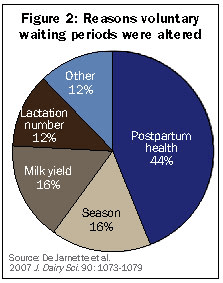The author is a professor of animal sciences at Kansas State University, Manhattan.
How long do you wait before you start A.I. breeding your cows after calving? That is the very definition of voluntary waiting period (VWP).
Setting the duration of your VWP should take into consideration a number of factors. Research indicates the reproductive tract of the cow requires approximately 30 to 40 days to undergo a healing process called involution after a normal calving. This process includes macro- and microscopic changes that prepare the reproductive tract, especially the uterus, for a renewed pregnancy.
Some, but not all, studies indicate that a longer VWP may improve conception rates possibly because of an improved uterine environment and more positive energy balance. Eight studies conducted before 1975 in heat detection herds showed that conception rates went up in a curvilinear fashion as interval to first A.I. breeding rose (Figure 1).

The colored spots in Figure 1 represent individual data points from the eight studies. Meanwhile, the line represents the average regression response across the days after calving for all eight studies. Note that change in conception rates improved very little after 70 days postpartum.
Is longer better?
Duration of the VWP may need to be longer when using timed A.I. programs. Evidence in one study (Tenhagen et al. 2003. Theriogenology 60:1527-1537) demonstrated that lactating cows, regardless of milk-producing ability, had greater pregnancy rates after a timed A.I. program (Ovsynch) when first insemination was delayed beyond the traditional 50 to 60 days. For example, in the highest-producing cows studied, pregnancy rate after timed A.I. improved when cows were inseminated between Days 94 and 102 rather than between Days 73 and 81.
To further validate the conclusions of the preceding study, survival and reproductive risk factors for culling in Holstein herds with at least 200 cows were calculated from 2.3 million DHI lactation records. The study included 727 herds with at least 200 cows from 2001 to 2006 (Devries et al. 2007. J. Dairy Sci. 93:613-623). Herds were located in 36 states, primarily east of the Mississippi River. Those researchers found that the risks for culling went up for cows that were in herds with shorter days to first insemination or had longer days to conception. Cows in herds that did not use a synchronized breeding program had slightly lower risks of culling than those in herds that at least possibly used a synchronized breeding program.
In a study published by the Animal Improvement Program Laboratory in Beltsville, Md., the VWP and adoption of synchronized breeding (ovulation synchronization followed by timed A.I.) were characterized from 33 million services of Holsteins and Jerseys in DHI herds (Miller et al. 2007. J. Dairy Sci. 90:1594-1606). Holstein cows that calved during March and April were bred later than those that calved during other months (February and March for Jerseys), whereas cows that calved during September and October were bred earlier.
First-lactation cows had longer days to first service than did older cows. The authors estimated the VWP to occur when at least 10 percent of cows had received their first A.I. breeding. Median (equal number of herds above and below) days to reach 10 percent of cows inseminated for the first time were 56 days. More than 65 percent of herds had 10 percent of cows inseminated by 60 days postpartum.
Herds that were identified as having synchronized breeding had the following characteristics when compared with herds that were classified as having traditional A.I. programs based mostly on heat detection:
Fewer days to first service (17 days)
More services (0.16 per cow)
Fewer days open (9.1 days)
Adoption of synchronized breeding for first services steadily grew from 1.9 percent of herd-years (2 percent of cows) for 1996 to 19.9 percent of herd-years (34.9 percent of cows) for 2005.
Another study (DeJarnette et al. 2007. J. Dairy Sci. 90:1073-1079) reported results from a survey that was mailed to approximately 4,000 dairy herds participating in a young sire progeny test program. The purpose was to estimate the percentage of herds that selectively altered their VWP for individual cows or groups of cows. Responses were received from 673 herds (17 percent) representing 583 Holsteins, 55 Jerseys, and 35 herds with other dairy breeds. The average VWP cited by respondents was 56 days, and ranged from 30 to 90 days, but did not differ by breed.
 Among responding herds, 64 percent (432/673) indicated the VWP was selectively altered for one or more reasons. The most frequently cited reason for altering the VWP was postpartum health (44 percent) followed by other reasons (Figure 2). In Holstein herds that altered the VWP based on milk yield, the best production group (greater than 88 pounds per cow) averaged 14 more days to first service than the worst production group (less than 44 pounds per cow) of energy-corrected milk. In contrast, days to first service were nearly identical for all production groups in Holstein herds that did not vary the VWP based on milk yield.
Among responding herds, 64 percent (432/673) indicated the VWP was selectively altered for one or more reasons. The most frequently cited reason for altering the VWP was postpartum health (44 percent) followed by other reasons (Figure 2). In Holstein herds that altered the VWP based on milk yield, the best production group (greater than 88 pounds per cow) averaged 14 more days to first service than the worst production group (less than 44 pounds per cow) of energy-corrected milk. In contrast, days to first service were nearly identical for all production groups in Holstein herds that did not vary the VWP based on milk yield.
When setting the duration of your herd VWP, you should consider all of the factors:
This article appears in the June 2012 issue of Hoard's Dairyman on page 423.
How long do you wait before you start A.I. breeding your cows after calving? That is the very definition of voluntary waiting period (VWP).
Setting the duration of your VWP should take into consideration a number of factors. Research indicates the reproductive tract of the cow requires approximately 30 to 40 days to undergo a healing process called involution after a normal calving. This process includes macro- and microscopic changes that prepare the reproductive tract, especially the uterus, for a renewed pregnancy.
Some, but not all, studies indicate that a longer VWP may improve conception rates possibly because of an improved uterine environment and more positive energy balance. Eight studies conducted before 1975 in heat detection herds showed that conception rates went up in a curvilinear fashion as interval to first A.I. breeding rose (Figure 1).

The colored spots in Figure 1 represent individual data points from the eight studies. Meanwhile, the line represents the average regression response across the days after calving for all eight studies. Note that change in conception rates improved very little after 70 days postpartum.
Is longer better?
Duration of the VWP may need to be longer when using timed A.I. programs. Evidence in one study (Tenhagen et al. 2003. Theriogenology 60:1527-1537) demonstrated that lactating cows, regardless of milk-producing ability, had greater pregnancy rates after a timed A.I. program (Ovsynch) when first insemination was delayed beyond the traditional 50 to 60 days. For example, in the highest-producing cows studied, pregnancy rate after timed A.I. improved when cows were inseminated between Days 94 and 102 rather than between Days 73 and 81.
To further validate the conclusions of the preceding study, survival and reproductive risk factors for culling in Holstein herds with at least 200 cows were calculated from 2.3 million DHI lactation records. The study included 727 herds with at least 200 cows from 2001 to 2006 (Devries et al. 2007. J. Dairy Sci. 93:613-623). Herds were located in 36 states, primarily east of the Mississippi River. Those researchers found that the risks for culling went up for cows that were in herds with shorter days to first insemination or had longer days to conception. Cows in herds that did not use a synchronized breeding program had slightly lower risks of culling than those in herds that at least possibly used a synchronized breeding program.
In a study published by the Animal Improvement Program Laboratory in Beltsville, Md., the VWP and adoption of synchronized breeding (ovulation synchronization followed by timed A.I.) were characterized from 33 million services of Holsteins and Jerseys in DHI herds (Miller et al. 2007. J. Dairy Sci. 90:1594-1606). Holstein cows that calved during March and April were bred later than those that calved during other months (February and March for Jerseys), whereas cows that calved during September and October were bred earlier.
First-lactation cows had longer days to first service than did older cows. The authors estimated the VWP to occur when at least 10 percent of cows had received their first A.I. breeding. Median (equal number of herds above and below) days to reach 10 percent of cows inseminated for the first time were 56 days. More than 65 percent of herds had 10 percent of cows inseminated by 60 days postpartum.
Herds that were identified as having synchronized breeding had the following characteristics when compared with herds that were classified as having traditional A.I. programs based mostly on heat detection:
Fewer days to first service (17 days)
More services (0.16 per cow)
Fewer days open (9.1 days)
Adoption of synchronized breeding for first services steadily grew from 1.9 percent of herd-years (2 percent of cows) for 1996 to 19.9 percent of herd-years (34.9 percent of cows) for 2005.
Another study (DeJarnette et al. 2007. J. Dairy Sci. 90:1073-1079) reported results from a survey that was mailed to approximately 4,000 dairy herds participating in a young sire progeny test program. The purpose was to estimate the percentage of herds that selectively altered their VWP for individual cows or groups of cows. Responses were received from 673 herds (17 percent) representing 583 Holsteins, 55 Jerseys, and 35 herds with other dairy breeds. The average VWP cited by respondents was 56 days, and ranged from 30 to 90 days, but did not differ by breed.
 Among responding herds, 64 percent (432/673) indicated the VWP was selectively altered for one or more reasons. The most frequently cited reason for altering the VWP was postpartum health (44 percent) followed by other reasons (Figure 2). In Holstein herds that altered the VWP based on milk yield, the best production group (greater than 88 pounds per cow) averaged 14 more days to first service than the worst production group (less than 44 pounds per cow) of energy-corrected milk. In contrast, days to first service were nearly identical for all production groups in Holstein herds that did not vary the VWP based on milk yield.
Among responding herds, 64 percent (432/673) indicated the VWP was selectively altered for one or more reasons. The most frequently cited reason for altering the VWP was postpartum health (44 percent) followed by other reasons (Figure 2). In Holstein herds that altered the VWP based on milk yield, the best production group (greater than 88 pounds per cow) averaged 14 more days to first service than the worst production group (less than 44 pounds per cow) of energy-corrected milk. In contrast, days to first service were nearly identical for all production groups in Holstein herds that did not vary the VWP based on milk yield.When setting the duration of your herd VWP, you should consider all of the factors:
- Postpartum uterine involution and health
- First-service pregnancy rate
- Current health status
- Milk yield
- Lactation number










